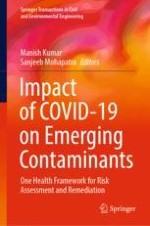The book brings out several unique perspectives of impacts of COVID-19 on the environment with special emphasis on the risk and remediation of emerging contaminants. Idea is to work out under the one health framework and comprehend not only scientific and technical aspects but also environmental, legal and policy aspects for water resources management. The obvious stress is given to the occurrence, fate and transport of geogenic, microbial and anthropogenic contaminants of emerging concern under the preview of the fact that antibiotic and antiviral use has been unprecedented during the global pandemic of COVID-19. At the same time, this edited volume touches upon the broader framework of integrated water resource management, as well as mitigation and removal strategies to put forward a holistic picture to the readers and policymakers. These contents are divided into three sections: a) monitoring, occurrence, distribution and fate of emerging contaminants; b) source and effects of these contaminants on the total environment; and c) treatment strategies, natural attenuation and mitigation.
